Seat Alhambra 2014 Owner's Manual
Manufacturer: SEAT, Model Year: 2014, Model line: Alhambra, Model: Seat Alhambra 2014Pages: 381, PDF Size: 5.75 MB
Page 271 of 381
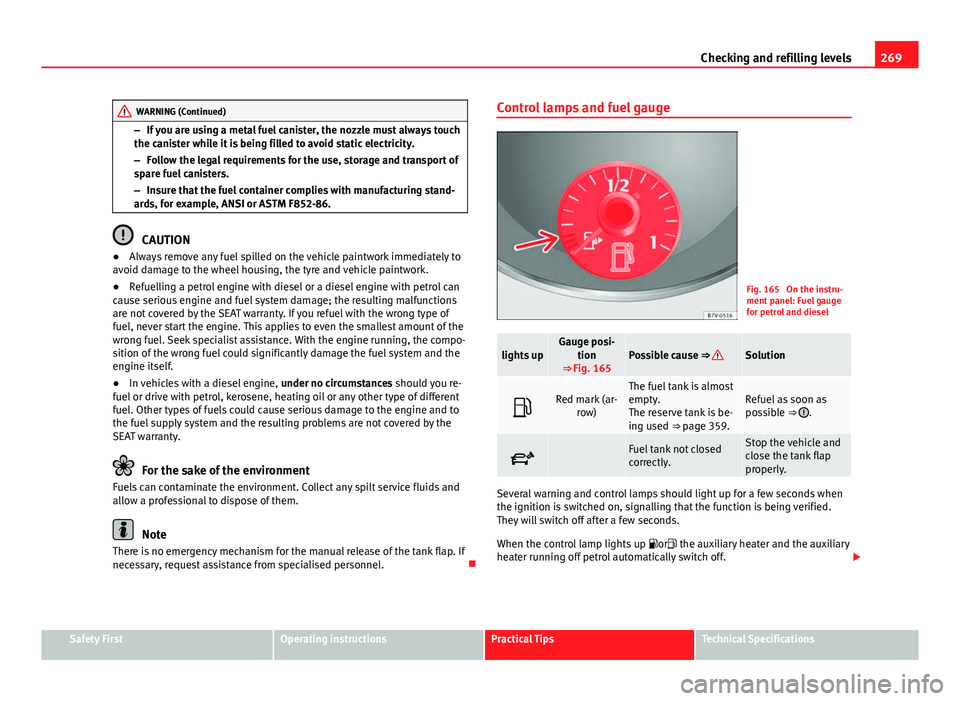
269
Checking and refilling levels
WARNING (Continued)
ŌĆō If you are using a metal fuel canister, the nozzle must always touch
the canister while it is being filled to avoid static electricity.
ŌĆō Follow the legal requirements for the use, storage and transport of
spare fuel canisters.
ŌĆō Insure that the fuel container complies with manufacturing stand-
ards, for example, ANSI or ASTM F852-86.
CAUTION
ŌŚÅ Always remove any fuel spilled on the vehicle paintwork immediately to
avoid damage to the wheel housing, the tyre and vehicle paintwork.
ŌŚÅ Refuelling a petrol engine with diesel or a diesel engine with petrol can
cause serious engine and fuel system damage; the resulting malfunctions
are not covered by the SEAT warranty. If you refuel with the wrong type of
fuel, never start the engine. This applies to even the smallest amount of the
wrong fuel. Seek specialist assistance. With the engine running, the compo-
sition of the wrong fuel could significantly damage the fuel system and the
engine itself.
ŌŚÅ In vehicles with a diesel engine, under no circumstances should you re-
fuel or drive with petrol, kerosene, heating oil or any other type of different
fuel. Other types of fuels could cause serious damage to the engine and to
the fuel supply system and the resulting problems are not covered by the
SEAT warranty.
For the sake of the environment
Fuels can contaminate the environment. Collect any spilt service fluids and
allow a professional to dispose of them.
Note
There is no emergency mechanism for the manual release of the tank flap. If
necessary, request assistance from specialised personnel. ’āÉControl lamps and fuel gauge
Fig. 165 On the instru-
ment panel: Fuel gauge
for petrol and diesel
lights upGauge posi-
tion
ŌćÆŌĆŖFig. 165Possible cause ŌćÆŌĆŖSolution
’üēRed mark (ar- row)The fuel tank is almost
empty.
The reserve tank is be-
ing used ŌćÆŌĆŖpage 359.Refuel as soon as
possible ŌćÆŌĆŖ.
’ā▓ Fuel tank not closed
correctly.Stop the vehicle and
close the tank flap
properly.
Several warning and control lamps should light up for a few seconds when
the ignition is switched on, signalling that the function is being verified.
They will switch off after a few seconds.
When the control lamp lights up ’āāor’üē the auxiliary heater and the auxiliary
heater running off petrol automatically switch off. ’éŻ
Safety FirstOperating instructionsPractical TipsTechnical Specifications
Page 272 of 381
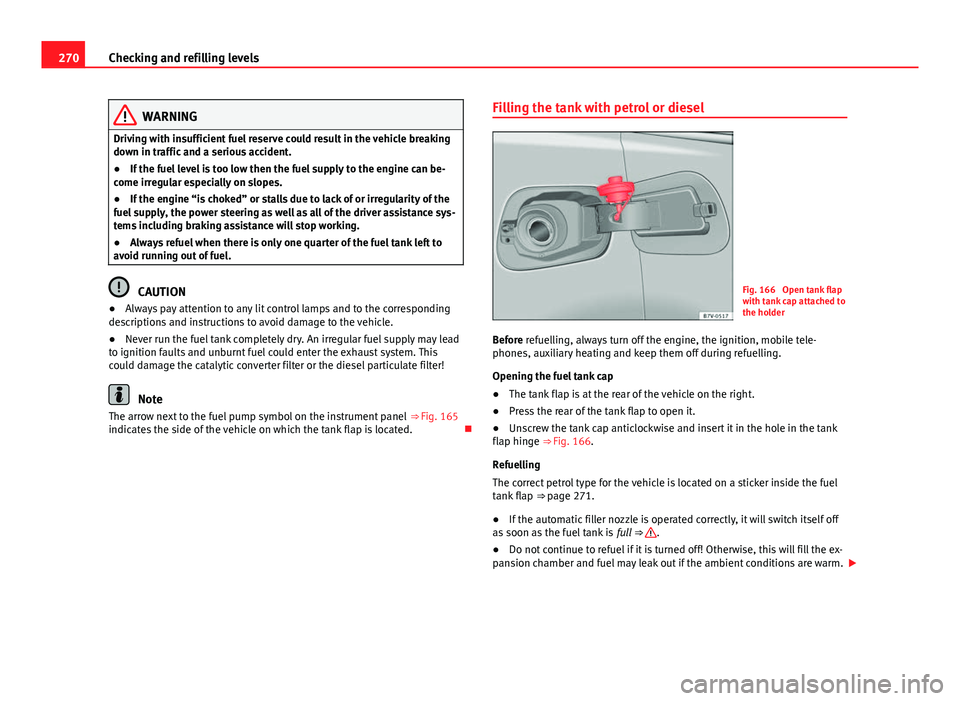
270Checking and refilling levels
WARNING
Driving with insufficient fuel reserve could result in the vehicle breaking
down in traffic and a serious accident.
ŌŚÅ If the fuel level is too low then the fuel supply to the engine can be-
come irregular especially on slopes.
ŌŚÅ If the engine ŌĆ£is chokedŌĆØ or stalls due to lack of or irregularity of the
fuel supply, the power steering as well as all of the driver assistance sys-
tems including braking assistance will stop working.
ŌŚÅ Always refuel when there is only one quarter of the fuel tank left to
avoid running out of fuel.
CAUTION
ŌŚÅ Always pay attention to any lit control lamps and to the corresponding
descriptions and instructions to avoid damage to the vehicle.
ŌŚÅ Never run the fuel tank completely dry. An irregular fuel supply may lead
to ignition faults and unburnt fuel could enter the exhaust system. This
could damage the catalytic converter filter or the diesel particulate filter!
Note
The arrow next to the fuel pump symbol on the instrument panel ŌćÆŌĆŖFig. 165
indicates the side of the vehicle on which the tank flap is located. ’āÉFilling the tank with petrol or diesel
Fig. 166 Open tank flap
with tank cap attached to
the holder
Before refuelling, always turn off the engine, the ignition, mobile tele-
phones, auxiliary heating and keep them off during refuelling.
Opening the fuel tank cap
ŌŚÅ The tank flap is at the rear of the vehicle on the right.
ŌŚÅ Press the rear of the tank flap to open it.
ŌŚÅ Unscrew the tank cap anticlockwise and insert it in the hole in the tank
flap hinge ŌćÆŌĆŖFig. 166.
Refuelling
The correct petrol type for the vehicle is located on a sticker inside the fuel
tank flap ŌćÆŌĆŖpage 271.
ŌŚÅ If the automatic filler nozzle is operated correctly, it will switch itself off
as soon as the fuel tank is full
ŌćÆŌĆŖ
.
ŌŚÅ Do not continue to refuel if it is turned off! Otherwise, this will fill the ex-
pansion chamber and fuel may leak out if the ambient conditions are warm. ’éŻ
Page 273 of 381
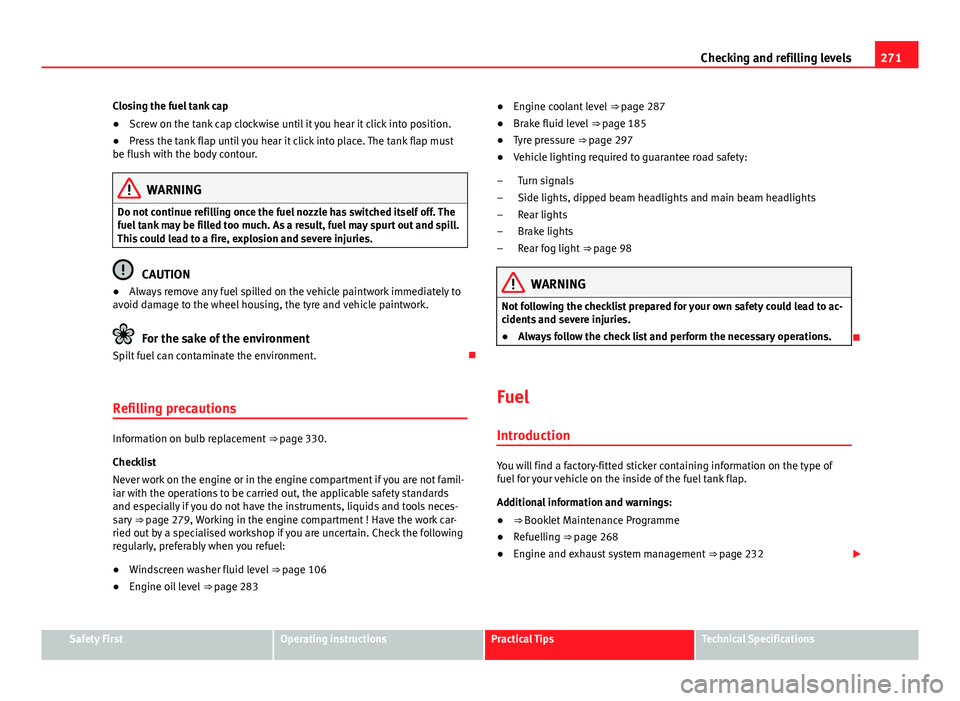
271
Checking and refilling levels
Closing the fuel tank cap
ŌŚÅ Screw on the tank cap clockwise until it you hear it click into position.
ŌŚÅ Press the tank flap until you hear it click into place. The tank flap must
be flush with the body contour.
WARNING
Do not continue refilling once the fuel nozzle has switched itself off. The
fuel tank may be filled too much. As a result, fuel may spurt out and spill.
This could lead to a fire, explosion and severe injuries.
CAUTION
ŌŚÅ Always remove any fuel spilled on the vehicle paintwork immediately to
avoid damage to the wheel housing, the tyre and vehicle paintwork.
For the sake of the environment
Spilt fuel can contaminate the environment. ’āÉ
Refilling precautions
Information on bulb replacement ŌćÆŌĆŖpage 330.
Checklist
Never work on the engine or in the engine compartment if you are not famil-
iar with the operations to be carried out, the applicable safety standards
and especially if you do not have the instruments, liquids and tools neces-
sary ŌćÆŌĆŖpage 279, Working in the engine compartment ! Have the work car-
ried out by a specialised workshop if you are uncertain. Check the following
regularly, preferably when you refuel:
ŌŚÅ Windscreen washer fluid level ŌćÆŌĆŖpage 106
ŌŚÅ Engine oil level ŌćÆŌĆŖpage 283 ŌŚÅ
Engine coolant level ŌćÆŌĆŖpage 287
ŌŚÅ Brake fluid level ŌćÆŌĆŖpage 185
ŌŚÅ Tyre pressure ŌćÆŌĆŖ page 297
ŌŚÅ Vehicle lighting required to guarantee road safety:
Turn signals
Side lights, dipped beam headlights and main beam headlights
Rear lights
Brake lights
Rear fog light ŌćÆŌĆŖpage 98
WARNING
Not following the checklist prepared for your own safety could lead to ac-
cidents and severe injuries.
ŌŚÅ Always follow the check list and perform the necessary operations.
’āÉ
Fuel Introduction
You will find a factory-fitted sticker containing information on the type of
fuel for your vehicle on the inside of the fuel tank flap.
Additional information and warnings:
ŌŚÅ ŌćÆŌĆŖBooklet Maintenance Programme
ŌŚÅ Refuelling ŌćÆŌĆŖpage 268
ŌŚÅ Engine and exhaust system management ŌćÆŌĆŖpage 232’éŻ
ŌĆō
ŌĆō
ŌĆō
ŌĆō
ŌĆō
Safety FirstOperating instructionsPractical TipsTechnical Specifications
Page 274 of 381
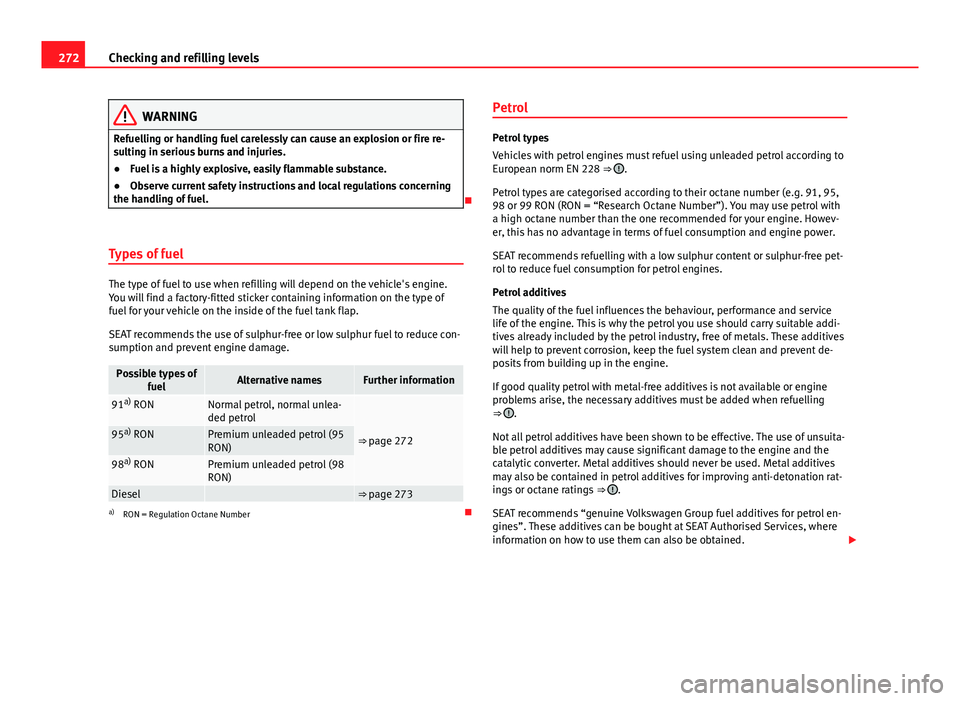
272Checking and refilling levels
WARNING
Refuelling or handling fuel carelessly can cause an explosion or fire re-
sulting in serious burns and injuries.
ŌŚÅ Fuel is a highly explosive, easily flammable substance.
ŌŚÅ Observe current safety instructions and local regulations concerning
the handling of fuel.
’āÉ
Types of fuel
The type of fuel to use when refilling will depend on the vehicle's engine.
You will find a factory-fitted sticker containing information on the type of
fuel for your vehicle on the inside of the fuel tank flap.
SEAT recommends the use of sulphur-free or low sulphur fuel to reduce con-
sumption and prevent engine damage.
Possible types of fuelAlternative namesFurther information
91a)
RONNormal petrol, normal unlea-
ded petrol
ŌćÆŌĆŖpage 27295 a)
RONPremium unleaded petrol (95
RON)
98 a)
RONPremium unleaded petrol (98
RON)
Diesel ŌćÆŌĆŖpage 273a) RON = Regulation Octane Number ’āÉPetrol
Petrol types
Vehicles with petrol engines must refuel using unleaded petrol according to
European norm EN 228 ŌćÆŌĆŖ
.
Petrol types are categorised according to their octane number (e.g. 91, 95,
98 or 99 RON (RON = ŌĆ£Research Octane NumberŌĆØ). You may use petrol with
a high octane number than the one recommended for your engine. Howev-
er, this has no advantage in terms of fuel consumption and engine power.
SEAT recommends refuelling with a low sulphur content or sulphur-free pet-
rol to reduce fuel consumption for petrol engines.
Petrol additives
The quality of the fuel influences the behaviour, performance and service
life of the engine. This is why the petrol you use should carry suitable addi-
tives already included by the petrol industry, free of metals. These additives
will help to prevent corrosion, keep the fuel system clean and prevent de-
posits from building up in the engine.
If good quality petrol with metal-free additives is not available or engine
problems arise, the necessary additives must be added when refuelling
ŌćÆŌĆŖ
.
Not all petrol additives have been shown to be effective. The use of unsuita-
ble petrol additives may cause significant damage to the engine and the
catalytic converter. Metal additives should never be used. Metal additives
may also be contained in petrol additives for improving anti-detonation rat-
ings or octane ratings ŌćÆŌĆŖ
.
SEAT recommends ŌĆ£genuine Volkswagen Group fuel additives for petrol en-
ginesŌĆØ. These additives can be bought at SEAT Authorised Services, where
information on how to use them can also be obtained. ’éŻ
Page 275 of 381
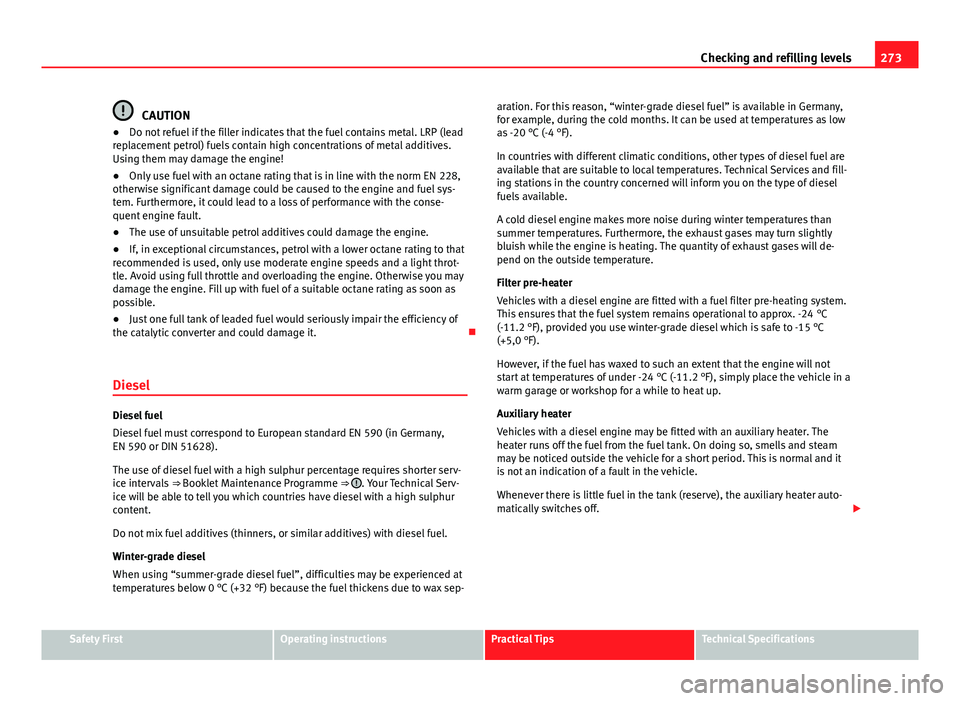
273
Checking and refilling levels
CAUTION
ŌŚÅ Do not refuel if the filler indicates that the fuel contains metal. LRP (lead
replacement petrol) fuels contain high concentrations of metal additives.
Using them may damage the engine!
ŌŚÅ Only use fuel with an octane rating that is in line with the norm EN 228,
otherwise significant damage could be caused to the engine and fuel sys-
tem. Furthermore, it could lead to a loss of performance with the conse-
quent engine fault.
ŌŚÅ The use of unsuitable petrol additives could damage the engine.
ŌŚÅ If, in exceptional circumstances, petrol with a lower octane rating to that
recommended is used, only use moderate engine speeds and a light throt-
tle. Avoid using full throttle and overloading the engine. Otherwise you may
damage the engine. Fill up with fuel of a suitable octane rating as soon as
possible.
ŌŚÅ Just one full tank of leaded fuel would seriously impair the efficiency of
the catalytic converter and could damage it. ’āÉ
Diesel
Diesel fuel
Diesel fuel must correspond to European standard EN 590 (in Germany,
EN 590 or DIN 51628).
The use of diesel fuel with a high sulphur percentage requires shorter serv-
ice intervals ŌćÆŌĆŖBooklet Maintenance Programme ŌćÆŌĆŖ
. Your Technical Serv-
ice will be able to tell you which countries have diesel with a high sulphur
content.
Do not mix fuel additives (thinners, or similar additives) with diesel fuel.
Winter-grade diesel
When using ŌĆ£summer-grade diesel fuelŌĆØ, difficulties may be experienced at
temperatures below 0 ┬░C (+32 ┬░F) because the fuel thickens due to wax sep- aration. For this reason, ŌĆ£winter-grade diesel fuelŌĆØ is available in Germany,
for example, during the cold months. It can be used at temperatures as low
as -20 ┬░C (-4 ┬░F).
In countries with different climatic conditions, other types of diesel fuel are
available that are suitable to local temperatures. Technical Services and fill-
ing stations in the country concerned will inform you on the type of diesel
fuels available.
A cold diesel engine makes more noise during winter temperatures than
summer temperatures. Furthermore, the exhaust gases may turn slightly
bluish while the engine is heating. The quantity of exhaust gases will de-
pend on the outside temperature.
Filter pre-heater
Vehicles with a diesel engine are fitted with a fuel filter pre-heating system.
This ensures that the fuel system remains operational to approx. -24 ┬░C
(-11.2 ┬░F), provided you use winter-grade diesel which is safe to -15 ┬░C
(+5,0 ┬░F).
However, if the fuel has waxed to such an extent that the engine will not
start at temperatures of under -24 ┬░C (-11.2 ┬░F), simply place the vehicle in a
warm garage or workshop for a while to heat up.
Auxiliary heater
Vehicles with a diesel engine may be fitted with an auxiliary heater. The
heater runs off the fuel from the fuel tank. On doing so, smells and steam
may be noticed outside the vehicle for a short period. This is normal and it
is not an indication of a fault in the vehicle.
Whenever there is little fuel in the tank (reserve), the auxiliary heater auto-
matically switches off.
’éŻ
Safety FirstOperating instructionsPractical TipsTechnical Specifications
Page 276 of 381
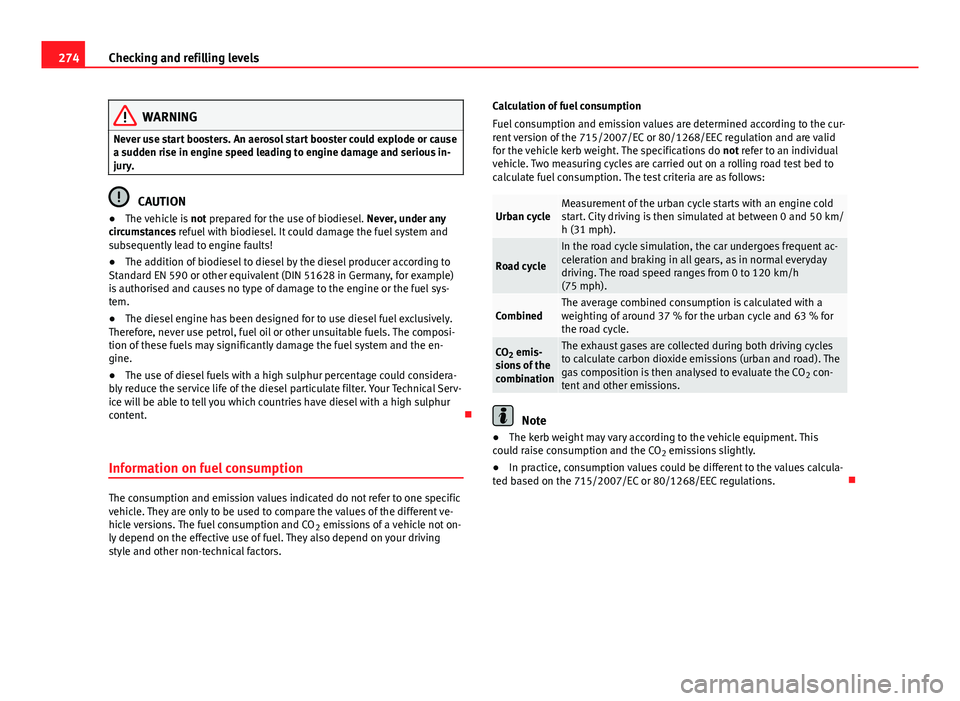
274Checking and refilling levels
WARNING
Never use start boosters. An aerosol start booster could explode or cause
a sudden rise in engine speed leading to engine damage and serious in-
jury.
CAUTION
ŌŚÅ The vehicle is not prepared for the use of biodiesel. Never, under any
circumstances refuel with biodiesel. It could damage the fuel system and
subsequently lead to engine faults!
ŌŚÅ The addition of biodiesel to diesel by the diesel producer according to
Standard EN 590 or other equivalent (DIN 51628 in Germany, for example)
is authorised and causes no type of damage to the engine or the fuel sys-
tem.
ŌŚÅ The diesel engine has been designed for to use diesel fuel exclusively.
Therefore, never use petrol, fuel oil or other unsuitable fuels. The composi-
tion of these fuels may significantly damage the fuel system and the en-
gine.
ŌŚÅ The use of diesel fuels with a high sulphur percentage could considera-
bly reduce the service life of the diesel particulate filter. Your Technical Serv-
ice will be able to tell you which countries have diesel with a high sulphur
content. ’āÉ
Information on fuel consumption
The consumption and emission values indicated do not refer to one specific
vehicle. They are only to be used to compare the values of the different ve-
hicle versions. The fuel consumption and CO 2 emissions of a vehicle not on-
ly depend on the effective use of fuel. They also depend on your driving
style and other non-technical factors. Calculation of fuel consumption
Fuel consumption and emission values are determined according to the cur-
rent version of the 715/2007/EC or 80/1268/EEC regulation and are valid
for the vehicle kerb weight. The specifications do
not refer to an individual
vehicle. Two measuring cycles are carried out on a rolling road test bed to
calculate fuel consumption. The test criteria are as follows:
Urban cycleMeasurement of the urban cycle starts with an engine cold
start. City driving is then simulated at between 0 and 50 km/
h (31 mph).
Road cycle
In the road cycle simulation, the car undergoes frequent ac-
celeration and braking in all gears, as in normal everyday
driving. The road speed ranges from 0 to 120 km/h
(75 mph).
CombinedThe average combined consumption is calculated with a
weighting of around 37 % for the urban cycle and 63 % for
the road cycle.
CO 2 emis-
sions of the
combinationThe exhaust gases are collected during both driving cycles
to calculate carbon dioxide emissions (urban and road). The
gas composition is then analysed to evaluate the CO 2 con-
tent and other emissions.
Note
ŌŚÅ The kerb weight may vary according to the vehicle equipment. This
could raise consumption and the CO 2 emissions slightly.
ŌŚÅ In practice, consumption values could be different to the values calcula-
ted based on the 715/2007/EC or 80/1268/EEC regulations. ’āÉ
Page 277 of 381
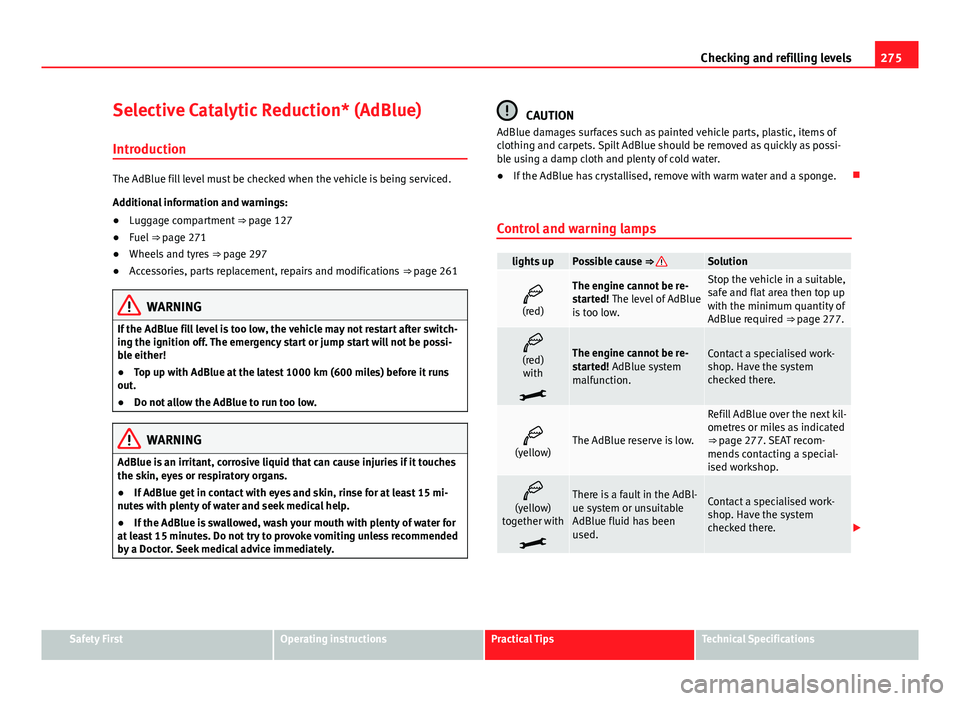
275
Checking and refilling levels
Selective Catalytic Reduction* (AdBlue)
Introduction
The AdBlue fill level must be checked when the vehicle is being serviced.
Additional information and warnings:
ŌŚÅ Luggage compartment ŌćÆŌĆŖpage 127
ŌŚÅ Fuel ŌćÆŌĆŖpage 271
ŌŚÅ Wheels and tyres ŌćÆŌĆŖpage 297
ŌŚÅ Accessories, parts replacement, repairs and modifications ŌćÆŌĆŖpage 261
WARNING
If the AdBlue fill level is too low, the vehicle may not restart after switch-
ing the ignition off. The emergency start or jump start will not be possi-
ble either!
ŌŚÅ Top up with AdBlue at the latest 1000 km (600 miles) before it runs
out.
ŌŚÅ Do not allow the AdBlue to run too low.
WARNING
AdBlue is an irritant, corrosive liquid that can cause injuries if it touches
the skin, eyes or respiratory organs.
ŌŚÅ If AdBlue get in contact with eyes and skin, rinse for at least 15 mi-
nutes with plenty of water and seek medical help.
ŌŚÅ If the AdBlue is swallowed, wash your mouth with plenty of water for
at least 15 minutes. Do not try to provoke vomiting unless recommended
by a Doctor. Seek medical advice immediately.
CAUTION
AdBlue damages surfaces such as painted vehicle parts, plastic, items of
clothing and carpets. Spilt AdBlue should be removed as quickly as possi-
ble using a damp cloth and plenty of cold water.
ŌŚÅ If the AdBlue has crystallised, remove with warm water and a sponge. ’āÉ
Control and warning lamps
lights upPossible cause ŌćÆŌĆŖSolution
’üŠ
(red)The engine cannot be re-
started! The level of AdBlue
is too low.Stop the vehicle in a suitable,
safe and flat area then top up
with the minimum quantity of
AdBlue required ŌćÆŌĆŖpage 277.
’üŠ
(red)
with
’üżThe engine cannot be re-
started! AdBlue system
malfunction.Contact a specialised work-
shop. Have the system
checked there.
’üŠ
(yellow)The AdBlue reserve is low.
Refill AdBlue over the next kil-
ometres or miles as indicated
ŌćÆŌĆŖpage 277. SEAT recom-
mends contacting a special-
ised workshop.
’üŠ
(yellow)
together with
’üżThere is a fault in the AdBl-
ue system or unsuitable
AdBlue fluid has been
used.Contact a specialised work-
shop. Have the system
checked there. ’éŻ
Safety FirstOperating instructionsPractical TipsTechnical Specifications
Page 278 of 381

276Checking and refilling levels
Several warning and control lamps should light up for a few seconds when
the ignition is switched on, signalling that the function is being verified.
They will switch off after a few seconds.
WARNING
If the warning lamps and messages are ignored, the vehicle may stall in
traffic, or may cause accidents and severe injuries.
ŌŚÅ Never ignore the warning lamps or text messages.
ŌŚÅ Stop the vehicle safely as soon as possible.
CAUTION
Failure to heed the control lamps and text messages when they appear may
result in faults in the vehicle. ’āÉ
Information on AdBlue
In vehicles with Selective Catalytic Reduction, a special urea solution (AdBl-
ue) is injected into the exhaust gas system in front of the catalytic converter
to reduce nitrogen oxide emissions. The consumption of AdBlue depends on individual driving style, the tem-
perature at which the system operates and the outside temperature where
the vehicle is driven.
AdBlue is kept in an independent tank in the vehicle and should be refilled
at an official supplier. The AdBlue tank holds about 17 litres.
A message will be displayed on the dash panel around 2400 km
(1500 miles) before the next service to indicate that AdBlue must be refilled
ŌćÆŌĆŖpage 277. If you ignore this message and do not refill, you will be unable
to start the engine afterwards
ŌćÆŌĆŖpage 275.
SEAT recommends contacting a specialised workshop. If you are unable to
visit a qualified specialised workshop, you should temporarily refill with a
minimum of 10.0 litres of AdBlue. Only refill using AdBlue expressly ap-
proved by SEAT.
When the indicators ’üŠ and ’üż light simultaneously, there is a fault. SEAT
recommends visiting the closest specialised workshop.
AdBlue ®
is a registered trademark in the US, Germany, the European Union
and other countries belonging to the German automobile industry ("Ver-
band der Automobilindustrie e. V.", VDA). ’āÉ
Page 279 of 381
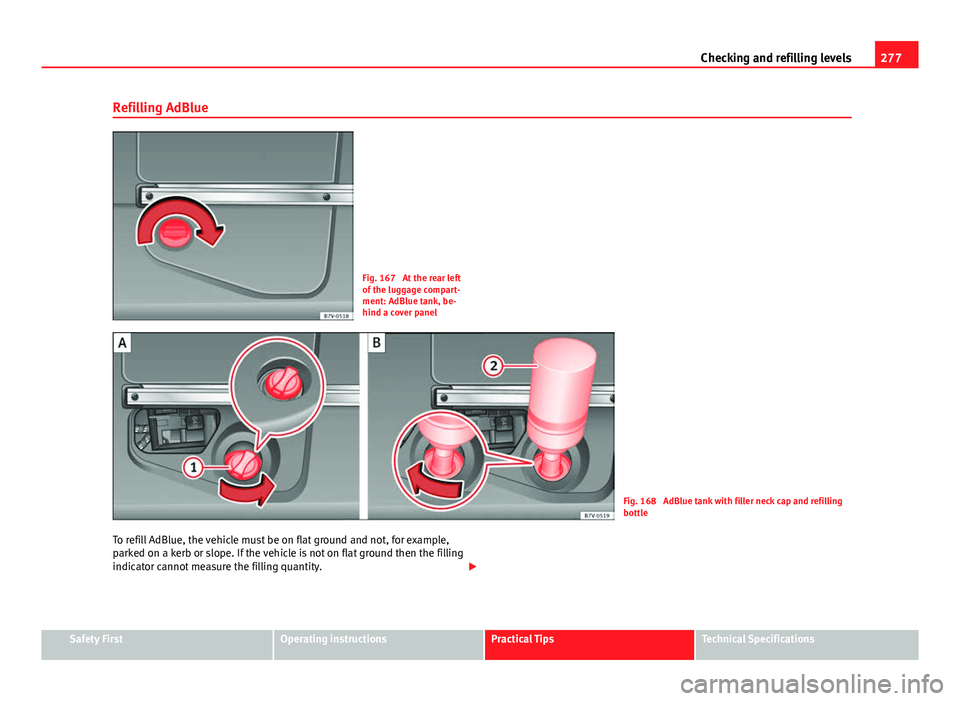
277
Checking and refilling levels
Refilling AdBlue
Fig. 167 At the rear left
of the luggage compart-
ment: AdBlue tank, be-
hind a cover panel
Fig. 168 AdBlue tank with filler neck cap and refilling
bottle
To refill AdBlue, the vehicle must be on flat ground and not, for example,
parked on a kerb or slope. If the vehicle is not on flat ground then the filling
indicator cannot measure the filling quantity. ’éŻ
Safety FirstOperating instructionsPractical TipsTechnical Specifications
Page 280 of 381
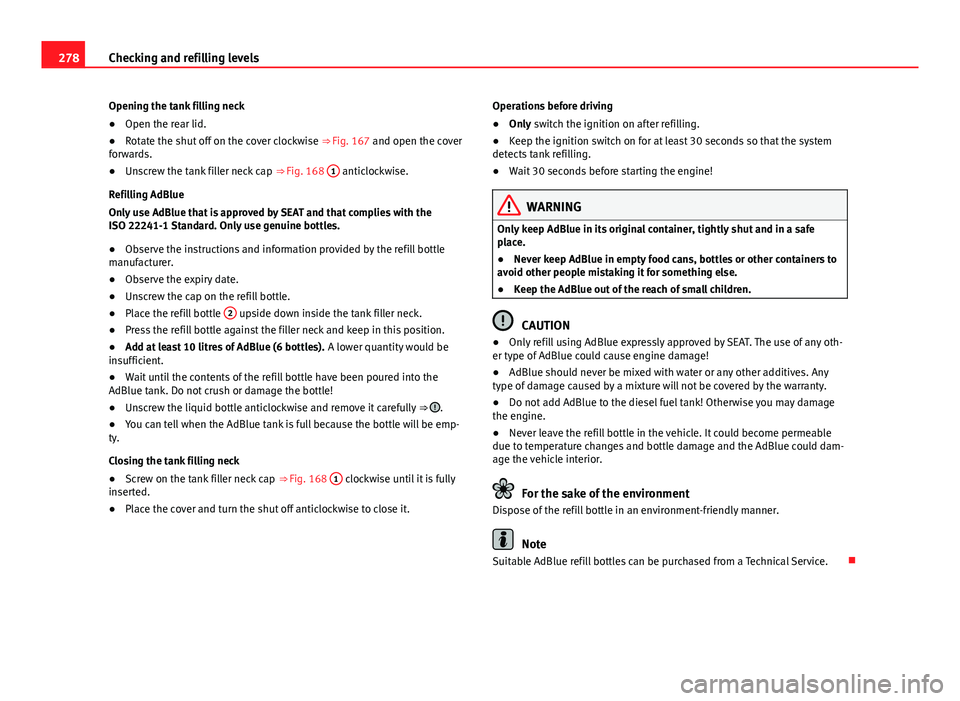
278Checking and refilling levels
Opening the tank filling neck
ŌŚÅ Open the rear lid.
ŌŚÅ Rotate the shut off on the cover clockwise ŌćÆŌĆŖFig. 167 and open the cover
forwards.
ŌŚÅ Unscrew the tank filler neck cap ŌćÆŌĆŖFig. 168 1
anticlockwise.
Refilling AdBlue
Only use AdBlue that is approved by SEAT and that complies with the
ISO 22241-1 Standard. Only use genuine bottles.
ŌŚÅ Observe the instructions and information provided by the refill bottle
manufacturer.
ŌŚÅ Observe the expiry date.
ŌŚÅ Unscrew the cap on the refill bottle.
ŌŚÅ Place the refill bottle 2
upside down inside the tank filler neck.
ŌŚÅ Press the refill bottle against the filler neck and keep in this position.
ŌŚÅ Add at least 10 litres of AdBlue (6 bottles). A lower quantity would be
insufficient.
ŌŚÅ Wait until the contents of the refill bottle have been poured into the
AdBlue tank. Do not crush or damage the bottle!
ŌŚÅ Unscrew the liquid bottle anticlockwise and remove it carefully ŌćÆŌĆŖ
.
ŌŚÅ You can tell when the AdBlue tank is full because the bottle will be emp-
ty.
Closing the tank filling neck
ŌŚÅ Screw on the tank filler neck cap ŌćÆŌĆŖFig. 168 1
clockwise until it is fully
inserted.
ŌŚÅ Place the cover and turn the shut off anticlockwise to close it. Operations before driving
ŌŚÅ
Only switch the ignition on after refilling.
ŌŚÅ Keep the ignition switch on for at least 30 seconds so that the system
detects tank refilling.
ŌŚÅ Wait 30 seconds before starting the engine!
WARNING
Only keep AdBlue in its original container, tightly shut and in a safe
place.
ŌŚÅ Never keep AdBlue in empty food cans, bottles or other containers to
avoid other people mistaking it for something else.
ŌŚÅ Keep the AdBlue out of the reach of small children.
CAUTION
ŌŚÅ Only refill using AdBlue expressly approved by SEAT. The use of any oth-
er type of AdBlue could cause engine damage!
ŌŚÅ AdBlue should never be mixed with water or any other additives. Any
type of damage caused by a mixture will not be covered by the warranty.
ŌŚÅ Do not add AdBlue to the diesel fuel tank! Otherwise you may damage
the engine.
ŌŚÅ Never leave the refill bottle in the vehicle. It could become permeable
due to temperature changes and bottle damage and the AdBlue could dam-
age the vehicle interior.
For the sake of the environment
Dispose of the refill bottle in an environment-friendly manner.
Note
Suitable AdBlue refill bottles can be purchased from a Technical Service. ’āÉ